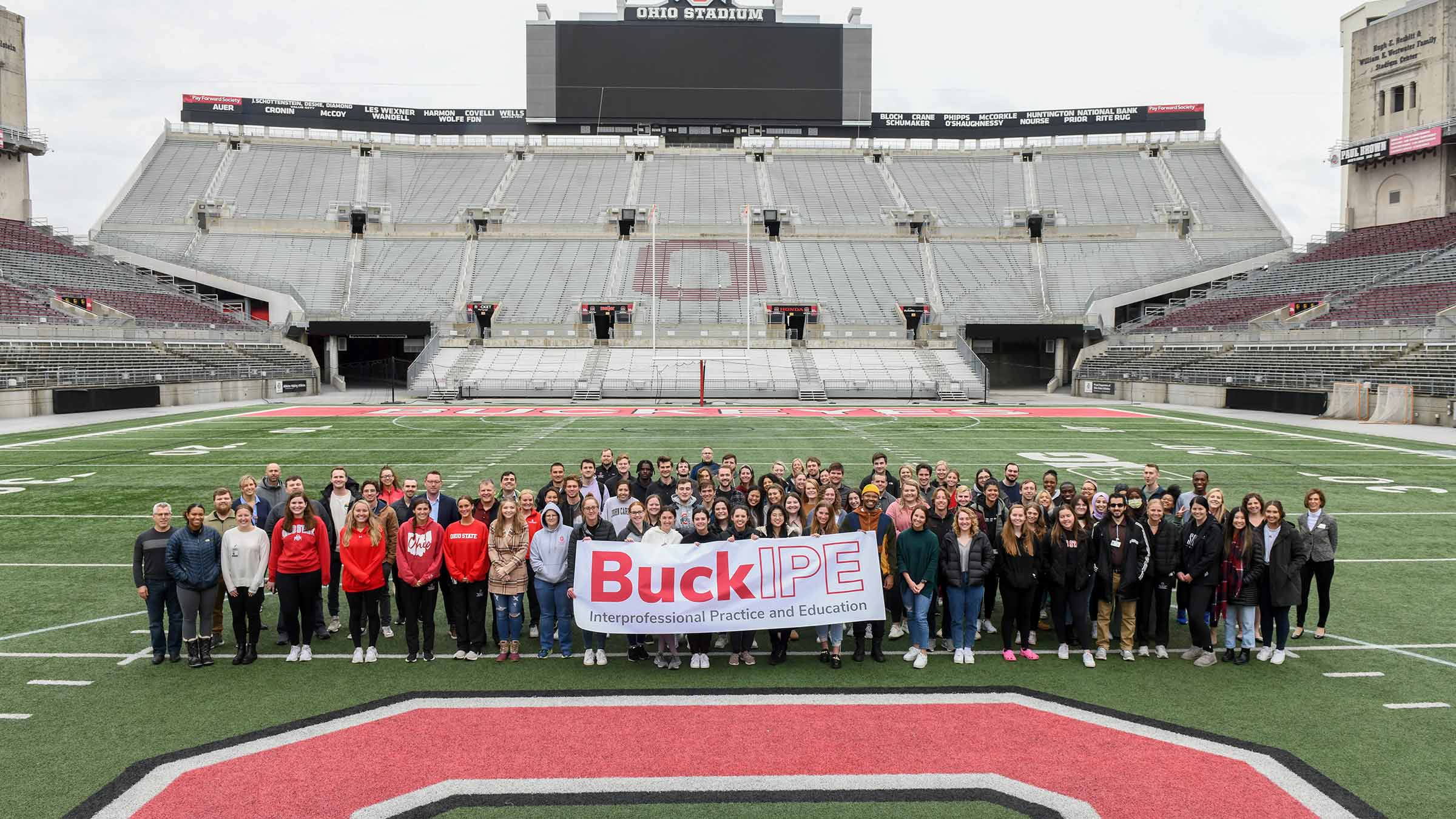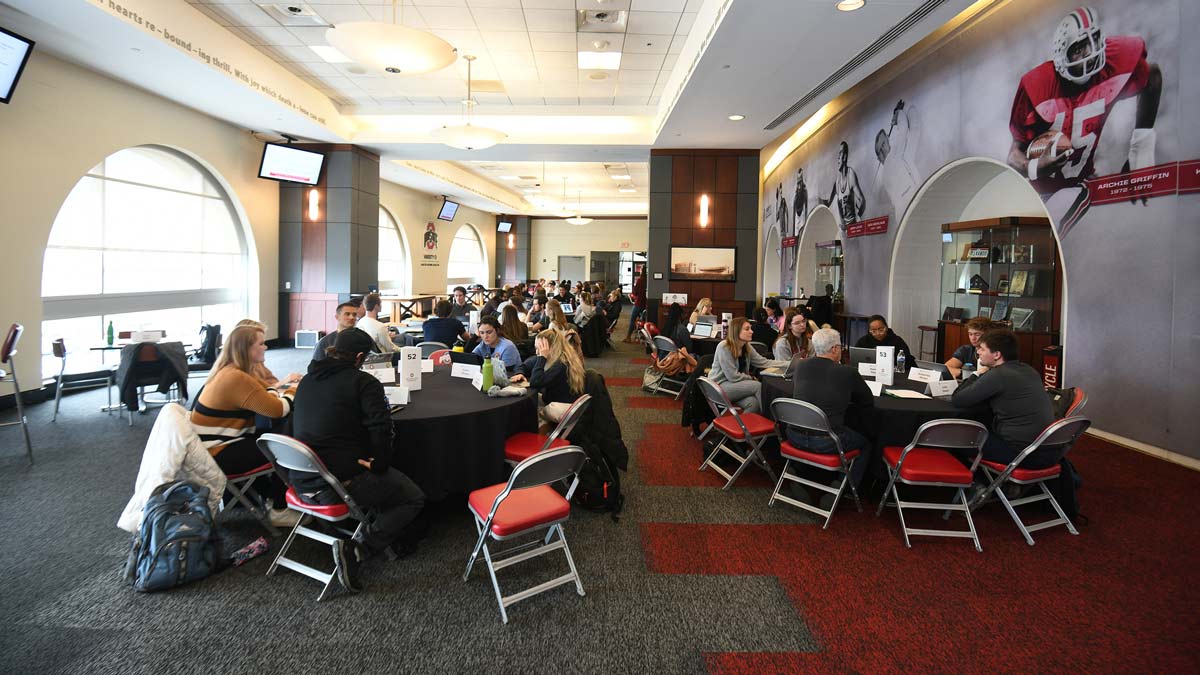Interprofessional education trains health care students to collaborate for patients' best health

Teamwork among health care providers is critical to achieving successful patient outcomes.
Future health care professionals at The Ohio State University embody teamwork from day one, in ways that might be surprising to outside observers.
Each fall, students become part of a collaborative team with other students across Ohio State’s seven health sciences colleges, including the colleges of Medicine, Dentistry, Optometry, Nursing, Pharmacy, Public Health and Veterinary Medicine, as well as students from the School of Health and Rehabilitation Sciences. The concept is called Interprofessional Practice and Education (IPE).
On a campus with the breadth and scale of The Ohio State University, future health care professionals have a unique opportunity to work with others from the disciplines they will encounter in their post-education careers — and understand how those interactions impact patient health.
Through the first two years of a program called, “BuckIPE,” the students are assigned to cross-disciplinary teams of eight and stay with that team throughout their education. Teams meet in person several times a year to discuss needs of individuals living with chronic disease, address population health needs, fill gaps in care and provide services in the community.

“The program spans two years and is designed to provide health science learners first-hand experiences working with patients, clients and communities as part of an interprofessional team while learning and applying competencies to improve communication, support effective collaboration and work at the top of their professional training to improve health and health care outcomes,” says Andrea Pfeifle, Associate Vice Provost for Interprofessional Practice and Education. This year, there are 165 teams of about 1,300 students.
Learn how Dr. Pfeifle is bridging the gap between health care education and health care delivery
Faculty across the seven health sciences colleges design training modules for the students, a “collaborative” process, says Alexa Valentino, a pharmacist and director for the BuckIPE curriculum.
“We want students to know they’re part of a team,” Valentino says. “It’s a necessary skill set.”
At a recent BuckIPE communication session held at Ohio Stadium, facilitator Stephen McGhee, DNP, clinical associate professor in the College of Nursing, said the focus of the day was for students to work together and to develop their understanding of other students’ roles.
“Our goal is that you leave feeling more prepared to work with other professions, not that you leave knowing the clinical answers,” he says.
Understanding other roles means learning terminology the students might not be familiar with. McGhee and other facilitators urged the students not to use words that are specific to their profession.
“As you are listening to each other, be sure to listen for understanding,” he says. “This is an opportunity for you to practice your communication skills and enhance your understanding of each other’s roles. The only silly questions are the ones that are not asked.”
Students learn about each other while taking on fictional patient cases. For instance, last fall they studied the case of a 14-year-old girl named Ellie whose frequent headaches and lack of appetite have caused her Spanish-speaking parents some concern, although they have difficulty relaying it in English to clinicians.
Students who aim to be doctors, nurses, dietitians, pharmacists, dentists and physical therapists contribute what they’ve learned in their areas of expertise to diagnose Ellie’s illness and suggest a care plan. Along the way, they learn that Ellie has a brain tumor, as well as an eating disorder.

Sydney Bellack, a first-year student in the College of Pharmacy, investigated the supplements that were found in Ellie’s bag, and discovered they were a natural weight-loss supplement called Garcinia cambogia. Bellack linked the pills to Ellie’s lab results, which displayed liver damage.
“Without that knowledge, other professions might not understand why that’s happening to a patient,” she says.
The program has been “really beneficial,” says Bellack, who’ll work in a hospital setting this summer.
“Before this, I’ve never worked with other interprofessional people. It’s interesting to hear everyone’s point of view.”
Also on her team was Zak Hussein, a first-year student majoring in Medical Laboratory Science in the School of Health and Rehabilitation Sciences. The Medical Laboratory Science program conducts sample testing of blood and other fluids — discovering behind-the-scenes information that doctors may not see. It was the second time Hussein’s group met in person this year to discuss the care of Ellie, whose story gets the group thinking and talking.
“I think it puts into perspective how important communication is in the process,” Hussein says.
Soon these interactive sessions will be held in the new Ohio State Interdisciplinary Health Sciences Center, located in the heart of the newly planned health sciences campus. It’s scheduled to open in 2023 and is being laid out to facilitate blending professionals from the university’s seven health science colleges. The center will house two large classrooms that can accommodate 150 or more trainees and can provide opportunities for collaborations that solve real health care problems for real patients in the community.
“Our medical students learn alongside health care professional students as early as their first year,” says Daniel Clinchot, MD, vice dean for Education at the College of Medicine. “Interprofessional education is woven into our curriculum at our college because we believe these learning experiences better prepare our students to face challenges as part of a health care team during their residency, and because of that, ultimately to provide better patient care.”






